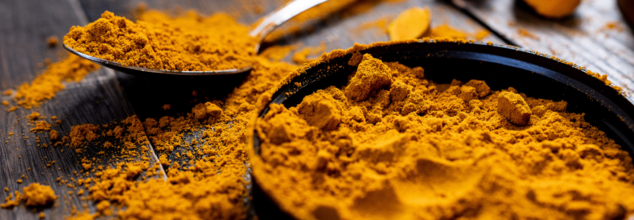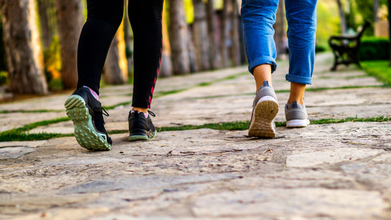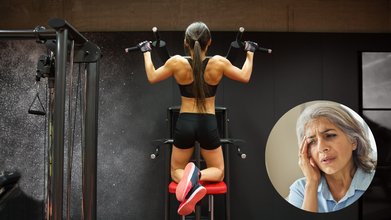- Health Conditions A-Z
- Health & Wellness
- Nutrition
- Fitness
- Health News
- Ayurveda
- Videos
- Medicine A-Z
- Parenting
- Web Stories
Can Yoga Improve Your Hearing? Ways Yoga Helps Better Our Ear Health

Yoga has a great impact on different aspects of our life. Whether it is our mental health or physical health, yoga plays a vital role. As such, it is no surprise that yoga has a wonderful effect on our hearing and ear health in general.
Hearing, much like other aspects of our body like eyesight, and speech, people mostly take for granted. Any changes in this, whether it is slight loss of hearing or ringing noises in your ears, can cause great discomfort for people. So how can we ensure its well-being? One of the surprising benefit yoga gives us is ear health.
As we journey through life, protecting and even enhancing our hearing becomes increasingly important. Interestingly, ancient practices like yoga and meditation offer a compelling pathway to better auditory health. Beyond stress relief, these techniques boost circulation and sharpen mental focus, creating a positive ripple effect for your ears.
Why Do We Lose Our Hearing?
Beverly Hills Hearing Center explains that hearing can fade for various reasons, including loud environments, infections, or underlying health issues. It might show up as struggling to follow conversations, constantly turning up the volume, or that persistent ringing we call tinnitus. While regular hearing checks are crucial for early detection, incorporating daily habits that support ear health is equally vital.
Yoga That Improves Our Ear Health
According to the Journal of Yoga & Physical Therapy, there are some easy things we can do, like simple neck exercises and deep breathing (called Kumbhak in yoga), to help get more blood and oxygen to our inner ears. Special high-pitched sounds might also help. Here are some poses and mudras you should know.
Nodding "Yes"
Gently lower your chin towards your chest, feeling a stretch in the back of your neck. Then, slowly lift your head back, looking upwards with ease. Repeat this gentle nodding motion several times, keeping it smooth and comfortable.
Tilting Head to Shoulder
Softly tilt your right ear towards your right shoulder, feeling a stretch on the left side of your neck. Then, gently tilt your left ear towards your left shoulder, stretching the right side. Alternate these gentle tilts.
Turning Head Side to Side
Slowly turn your head to look over your right shoulder, holding briefly. Return to the center and then gently turn your head to look over your left shoulder. Repeat this smooth turning motion.
Full Head Circle (360° Head Rotation)
Sitting tall, gently drop your chin to your chest. Slowly roll your right ear towards your right shoulder, then your head back, then your left ear to your left shoulder, completing a slow circle. Repeat in the opposite direction.
Shanmukhi Mudra
Sit comfortably. Place thumbs on ear flaps, index fingers on forehead, middle fingers on eyes, ring fingers on nostrils, and little fingers on upper lip. Inhale deeply, then exhale with a high-pitched humming sound, feeling the vibrations.
Holding Your Breath (Kumbhak)
Sit comfortably, placing index and middle fingers on your forehead. Close your right nostril with your thumb and inhale deeply through the left. Close both nostrils and hold your breath. Then, exhale slowly through your right nostril.
Blowing a Conch Shell (Shankha Naad)
Sit upright, gently tilting your head back. Take a deep breath and blow into the conch shell, gradually increasing the force to create a rising pitch. Focus on the sound and the vibration it creates.
Long Walks Vs Several Short Walks? Study Reveals Which One Is Better For Your Health

(Credit-Canva)
Walking is said to be one of the best exercises. Not only is it an easy and accessible exercise, but it can be done anywhere and also does not need a lot of equipment. Many people aim for 10,000 steps a day as a sign of good health. But should you take one long walk, or multiple short ones? A new study has answered this question.
New research suggests that a single, longer walk each day is better for your heart than breaking up your steps into many short strolls, especially if you don't exercise regularly.
The study, published in Annals of Internal Medicine, found that walking for at least 15 minutes without stopping is ideal. This longer, steady pace, which is about 1,500 continuous steps gives your heart a much better workout.
Longer Vs Shorter Walks: Which is Better?
Researchers tracked the walking habits of over 33,500 adults in the UK who walked less than 8,000 steps a day. After tracking their health for eight years, the findings were clear:
Lower Heart Risk
People who consistently walked in longer, uninterrupted stretches had a lower risk of heart problems compared to those who only took short, quick bursts of steps.
Why Are Longer Walks Better For Health?
Even among the least active group (those walking under 5,000 steps daily), taking longer walks made a major difference. Their risk of heart disease and early death dropped significantly.
The researchers explain that most people focus only on the number of steps they take, but not the patterns. They suggests that even inactive people can boost heart health by changing their habits to walk for at least 10–15 minutes at a time.
Should People Focus More On How They Walk Or How Much?
Many people aim for 10,000 steps a day, but that number actually came from an old pedometer advertisement, not science. While experts agree more steps are generally good, this study emphasizes that how you walk matters more than just the total step count.
The researchers suggest that simple changes, like setting aside time specifically for a long walk, could make a big impact on heart health.
The NHS still recommends getting 150 minutes of moderate activity like brisk walking, each week, and ideally it should be spread out. For older adults, moving every day, even with light activity around the house, is key.
It's important to know that while the study shows a strong link between longer walks and better health, it doesn't definitively prove that walking directly causes the improvement.
However, health experts agree exercise is vital. They explain that you might find it hard at first, but it will get easier as your body adjusts. Even small improvements contribute to a healthy heart.
What Are Some Safety Tips for Walkers?
While walking is generally a safe activity, accidents can happen, especially if you like to walk alone. To stay safe while walking,
Be Visible
Wear bright, reflective clothing or carry a flashlight after dark or in dim light so drivers and others can easily spot you.
Stay Alert
Focus on your immediate surroundings; avoid distractions like your phone or headphones to always know what's happening around you, especially traffic.
Use Paths
Walk or bike only on marked paths, lanes, or sidewalks, and cross streets at designated crosswalks where vehicles are expecting pedestrians.
Donald Trump Health Update: First Hand Bruise, Now Swollen Ankle, Is The President Hiding A Health Crisis?

Credits: AFP/X
Donald Trump health has become a heated topic of debate and the concerns around his health has resurfaced after a photo from his Kuala Lumpur visit on Sunday, October 26, went viral. He was spotted with swollen ankles. The photo that went viral is from a meting of the Association of Southeast Asian Nations (ASEAN), which kicked off his six-day trip.
The pictures of his swollen ankle have flooded on social media and people are saying that his ankle is seen to be extremely swollen. As per experts, this happens due to chronic venous insufficiency, which is a condition Trump had earlier announced to be suffering from.

Chronic venous insufficiency occurs when the veins in the legs have trouble sending back to the heart. This causes blood to pool and creating high pressure. This is usually caused by damaged or weakened valves in the veins and is characterized by symptoms like leg swelling, aching, and heaviness, which improves with elevation. Risk factors include age, a history of deep vein thrombosis, and prolonged periods of sitting or standing.
However, Trump's latest physical test says something else. The White House physician Sean P Barbabella declared that the president "remains in exceptional health, exhibiting strong cardiovascular, pulmonary, neurological, and physical performance". Barbabella also stated that his "cardiac age was found to be approximately 14 years younger than his chronological age".
Trump's Legs Could Also Reveal That He Had A Stroke
As per a "Physical Therapist", who posts videos on Instagram by the username @epistemiccrisis with 74.2k followers, Trump also had his peroneal nerve paralyzed. He explains, "The deep branch of common peroneal nerve, which supplies a muscle known as the tibialis anterior, which blends your foot up toward your head when you walk. This is known as dorsiflexion. If this nerve is paralyzed, you would get a foot drop."
However, he notes that this can be easily remedied with a brace, called ankle foot orthosis or AFO. He said that the president was most likely wearing it as the outline of the posterior portion of "what looks like an AFO" could be seen through his pants.
Concerns On Trump's Health
Previously, the same "Physical Therapist" claimed that President Trump had a stroke. This is because he had difficulty walking in a straight line. In fact, a 2021 study published in journal Healthcare notes that stroke is a major cause of disability worldwide and balance impairments are common disabling factors in patients with stroke, which could lead to falls.
However, as per the official medical records of the president, no such strokes were mentioned. His medical report pronounced him in "excellent health". The examination was done at Walter Reed National Military Medical Center. The report also emphasized that Trump maintains a "demanding daily schedule without restriction". Not only that, the report has gone so far to declare Trump's cardiac age as 14 years younger than his actual age after an electrocardiogram.
This Simple Grip Test Could Predict Your Dementia Risk

Credits: Canva
Dr Peter Attia, physician, and researcher known for his work in longevity medicine believes that there is a correlation between your grip strength and dementia onset risk and dementia mortality.
Dr Attia says, "My best explanation for this is that grip strength is itself a proxy for overall strength. The type of strength we are talking about here is acquired, not inherited. You had to do a bunch of work to get it, and it is the work you did that is actually what's protect your brain."
He says that women who are over 40, must be able to hand on a bar for a minute and a half, and for men, it is two minutes. The key is that you are supposed to be able to carry 75% of your weight, he says, in an interview with CBS News' 60 minutes.
Is There Any Truth In The Claim That Grip Strength Has A Correlation With Dementia?
As per a 2021 study published in journal Frontiers in Aging Neuroscience, titled Grip Strength and the Risk of Cognitive Decline and Dementia: A Systematic Review and Meta-Analysis of Longitudinal Cohort Studies, loss of grip strength and cognitive impairment are prevalent in the elderly, and they may share the pathogenesis in common.
The study found that poorer grip strength was in fact associated with more risk of cognitive decline and dementia. The subgroup analysis within the study also indicated that people with poorer strength had more risk of Alzheimer's disease and non-AD dementia.
But why does this happen? Lower grip strength is a marker for overall muscle mass, general health, and is linked to the health of the brain and its blood vessels. This link is also connected to other factors like vascular health, cognitive decline, and physical activity, as low grip strength can be a symptom of poor overall physical and metabolic health.
How Is Lower Grip Strength Is Linked To Dementia?
Indicator Of Overall Health: Grip strength reflects the health of entire body, this is why a lower grip strength is an indicate of lower muscle mass, and general poor health.
Vascular and brain health: Since there is a connection between muscle strength, blood flow, and brain health, thus lower grip strength is associated with a higher risk of vascular dementia and a greater volume of white matter hyperintensities in the brain.
Also Read: What Home Gym Tools Can Help You Stay Fit Without Hitting The Gym?
Poorer grip strength is associated with lower cognitive function, such as fluid intelligence and prospective memory. This suggest a link between the body's physical capabilities and the brain's cognitive abilities.
A different study published in 2022, where 40,000 participants from the UK Biobank were studied found that greater grip strength was associated with better cognitive functioning, higher life satisfaction, greater subjective well-being, and reduced depression and anxiety symptoms while controlling for numerous demographic, anthropometric, and socioeconomic cofounders.
The study also found that grey matter volume of subcortical region also correlated with better mental health and considerably mediated their relationship with grip strength.
© 2024 Bennett, Coleman & Company Limited

